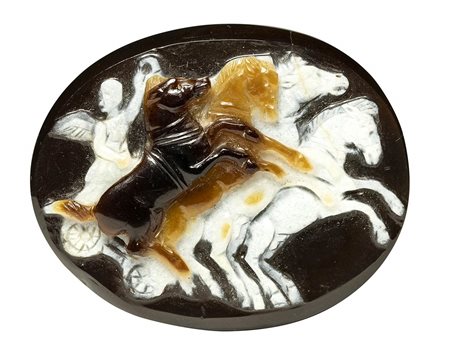 Bertolami Fine Art - Bertolami Fine Art, 1 Harewood Place 1, W1S 1BU Londra
Bertolami Fine Art - Bertolami Fine Art, 1 Harewood Place 1, W1S 1BU Londra
ASTA 107 - Glittica Sessione Unica
venerdì 22 aprile 2022 ore 15:00 (UTC +00:00)
A large sardonyx roman cameo. Victory driving a quadriga. 1st-2nd century A.D.
A large sardonyx roman cameo. Victory driving a quadriga.
1st-2nd century A.D.
The winged figure is tunicated, with naked arms, with the head turned back; with her right arm she holds the reins, with her left she raises a crown as a sign of triumph. The four horses gallop to the right, pulling the small chariot, whose wheels have about 8/10 spokes forming a kind of flower. The front legs of the animals are raised and arched. The cameo, of exceptional size, is engraved on a four-layered sardonyx. Starting from the bottom, the female figure is sculpted in the white layer, like two horses; a third horse is honey-colored, while the fourth (in the foreground) is brown. The different colors of the horses symbolize, according to Winckelmann, twilight-night, day and dawn; in fact usually the guide of such a chariot is Eos (Aurora). But the presence of the wings and the crown are attributable to the Victory. Fine composition, spontaneous and dynamic. The style and technique are reminiscent of a sardonyx cameo in the British Museum (1867,0507.284), while the composition and iconography certainly reminds the splendid sardonyx cameo in the Archeological Museum of Naples (Farnese Collection).
See: U. Pannuti, La collezione glittica, vol.2, p. 188-189 n. 156; Winckelmann, Saggio sull'Allegoria, in Opere, vol. VII, Prato 1831 pp. 463-465).The cameo is in excellent condition and has only a small crack at the top that starts from the edge to descend on the front part of the two white horses (cameo is solid). The cameo was originally mounted on a Victorian metal snuffbox, and the edges of the stone, like the back, were probably re-polished in the 19th century, at the same time as the stone was adapted to the snuffbox. Specimen of great beauty and rarity.
42 x 52 x 0,9 mm








